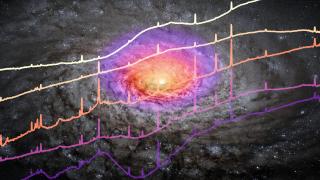Bibcode
Font, J.; Beckman, J. E.; Martínez-Valpuesta, I.; Borlaff, A. S.; James, P. A.; Díaz-García, S.; García-Lorenzo, B.; Camps-Fariña, A.; Gutiérrez, L.; Amram, P.
Bibliographical reference
The Astrophysical Journal, Volume 835, Issue 2, article id. 279, 21 pp. (2017).
Advertised on:
2
2017
Journal
Citations
45
Refereed citations
42
Description
We have used Spitzer images of a sample of 68 barred spiral galaxies in
the local universe to make systematic measurements of bar length and bar
strength. We combine these with precise determinations of the corotation
radii associated with the bars, taken from our previous study, which
used the phase change from radial inflow to radial outflow of gas at
corotation, based on high-resolution two-dimensional velocity fields in
Hα taken with a Fabry–Pérot spectrometer. After
presenting the histograms of the derived bar parameters, we study their
dependence on the galaxy morphological type and on the total stellar
mass of the host galaxy, and then produce a set of parametric plots.
These include the bar pattern speed versus bar length, the pattern speed
normalized with the characteristic pattern speed of the outer disk
versus the bar strength, and the normalized pattern speed versus { R },
the ratio of corotation radius to bar length. To provide guidelines for
our interpretation, we used recently published simulations, including
disk and dark matter halo components. Our most striking conclusion is
that bars with values of { R } < 1.4, previously considered
dynamically fast rotators, can be among the slowest rotators both in
absolute terms and when their pattern speeds are normalized. The
simulations confirm that this is because as the bars are braked, they
can grow longer more quickly than the outward drift of the corotation
radius. We conclude that dark matter halos have indeed slowed down the
rotation of bars on Gyr timescales.
Related projects

Kinematic, Structural and Composition Studies of the Interstellar and Intergalactic Media
The basic objective of the broject is to investigate the evolution of galaxies by deepening our understanding of the interaction between the insterstellar medium and the stars.The main technique which we use is the two-dimensional kinematic study of whole galaxies observed using our instrument:GHaFaS, a Fabry-Perot interferometer on the William
Prof.
John E. Beckman

Nuclear Activity in Galaxies: a 3D Perspective from the Nucleus to the Outskirts
This project consists of two main research lines. First, the study of quasar-driven outflows in luminous and nearby obscured active galactic nuclei (AGN) and the impact that they have on their massive host galaxies (AGN feedback). To do so, we have been granted time with the Gran Telescopio CANARIAS (GTC) in the optical and near-infrared ranges
Cristina
Ramos Almeida